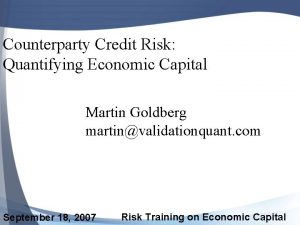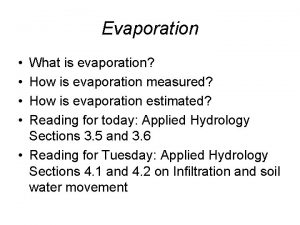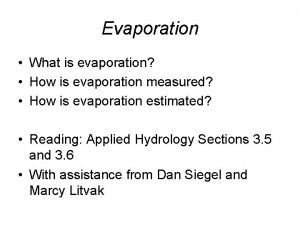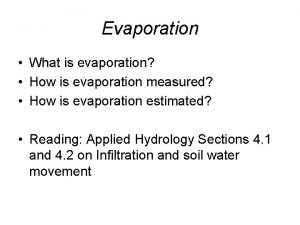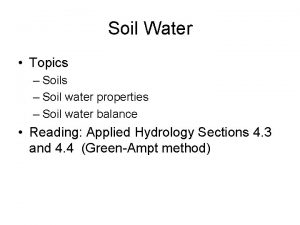Quantifying Rates of Soil Water Evaporation Implementing a








- Slides: 8

Quantifying Rates of Soil Water Evaporation: Implementing a Soil Water Oxygen Isotope Model in Matlab Erik Oerter EPS 209 27 April 2011

Project Motivation: Soil Water Oxygen Isotopes Soil Water originates as meteoric water, preserving the isotopic signature of precipitation Hydrogen and Oxygen isotopes undergo Rayleigh fractionation as water evaporates Enrichment in 18 O relative to precipitation The 18 O/16 O can be sampled: Directly as soil water (contemporary water) Indirectly as Ca. CO 3 (ancient water) Use 18 O/16 O to estimate evaporation rate Climate Proxy

Evaporation Rate via Soil Water Oxygen Isotopes Evap. Rate 18 O/16 O of water Depth in soil profile at “z” in soil profile 18 O/16 O of water at depth Diff coef. of water in soil Depth of evap. front 18 O/16 O of water at evap. front L = Total depth of soil profile (Barnes and Allison, 1988, J. of Hydrology)

Project Idea: Fit modeled Oxygen isotope profile to observed data and find the evaporation rate Model 18 O profile Observed 18 O profile Data from Wang et al. , 1996

Project Approach: m-file Sequence of Events 1) Load in observed data as text file 2) Initialize variables - Make an initial guess for evaporation rate - Populate a vector with evap guesses (~100) Specify the step between evap guesses - Initialize a matrix for calculated 18 O profiles (# depth increments x # evap guesses) 3) Loop over all evap guesses, calculating 18 O profiles - Now have 100 18 O profiles…

Project Approach: m-file Sequence of Events

Some Results Diffusion Coefficient of Water in Soil = 1. 5*10 -10 m 2/sec Starting Evap Rate Guess = 5 x 10 -11 m/sec (0. 15 cm/year) E guess step = 1*10 -12 m/sec Best fit Evap rate = 1. 02*10 -10 m/sec (0. 32 cm/year) 18 O/16 O -9 -8 -7 -6 -5 -4 -3 0 0. 1 0. 2 Depth 0. 3 0. 4 0. 5 0. 6 0. 7 0. 8 Observed 0. 9 Model 1 -2

Future Work This interpretation of the Barnes and Allison Model: - Single wet soil zone with the evaporating front at the surface Barnes and Allison envisioned a dry zone of soil overlying the wet zone and evaporating front at some depth Implement the two zone scheme - Allow for a migrating (+/- depth) evaporation front Allow for resetting of the 18 O input value (Allow it to rain on the soil)







